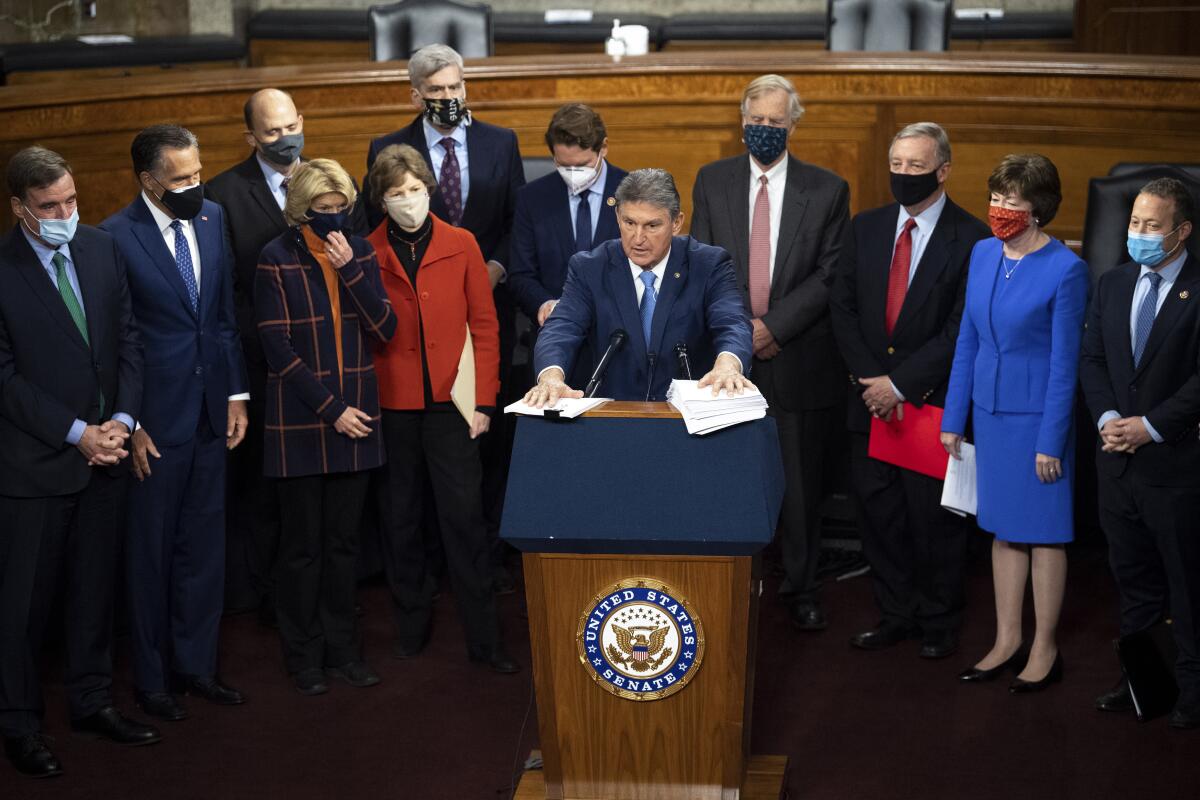Column: Sen. Joe Manchin drives Democrats crazy. Here’s why they need more senators like him

Sen. Joe Manchin, the self-styled conservative Democrat from West Virginia, is driving progressives crazy — and he doesn’t seem to mind.
Manchin says President Biden’s $1.9-trillion COVID relief bill is too big, and he wants to cut it. He says he strongly opposes a $15 federal minimum wage, one of Biden’s top campaign promises. He announced last week that he won’t vote to confirm Biden’s nominee to head the Office of Management and Budget, Neera Tanden, because her campaign-year tweets struck him as too partisan. He hasn’t decided whether to support Biden’s choice for Interior secretary, Deb Haaland, because she has advocated tough regulation of coal and natural gas, two important industries in West Virginia.
His refusal to back Tanden, an Indian American, and Haaland, a Native American, drew fury from progressives, who pointed out that both are women of color.
Rep. Alexandria Ocasio-Cortez (D-N.Y.) complained on Twitter that Manchin voted to confirm many of then-President Trump’s controversial nominees, “yet the first Native woman to be Cabinet Sec is where [he] finds unease?”
But the Senate’s Democratic leaders are staying out of the fray, giving Manchin a great deal of deference for a simple, practical reason: He’s their 50th vote.
Former security officials testified before Congress on Tuesday, saying they didn’t know extremists planned to storm the Capitol building on Jan. 6.
Without Manchin, they don’t have a working majority. Even with Manchin on their side, they still need Vice President Kamala Harris to break tie votes.
Asked if his party has a Joe Manchin problem, Senate Democratic Whip Richard J. Durbin of Illinois told a television interviewer: “We have a 50-50 problem.”
Manchin is an unusual character in the increasingly polarized Senate: a Democrat who voted in favor of Trump’s position on legislation more than half the time, and who seeks to split almost every issue down the middle.
He’s a throwback to the age when Southern Democrats like his predecessor Robert C. Byrd became power brokers precisely because their votes were unpredictable.
“This place doesn’t work the way it’s supposed to anymore,” Manchin told me in December, referring to the Senate. “We’re generally disgusted with not getting anything done.”
He has urged Biden to build bipartisan coalitions with Republicans, and offered himself as a mediator. “Let me know what you’d like to accomplish, and I can help,” he said, quoting one of his conversations with the president.
He’s disappointed that Biden, in pursuit of quick passage for his COVID-19 relief bill, has largely ignored his advice.
It’s hard to avoid the impression that Manchin enjoys being the man in the middle — the senator both sides want to woo.
But his split-the-difference positions also reflect who he is and where he’s from: a culturally conservative, anti-abortion, pro-business Democrat from a desperately poor coal state.
His greatest passion in the Senate has nothing to do with ideology; it’s making sure West Virginia gets as much federal spending as possible.
In pursuit of that goal, he has been willing to evolve. Long a dogged defender of coal mining — as governor of West Virginia, he sued the Environmental Protection Agency over its ban on mountaintop removal — he has seemingly come to accept that coal jobs will never come back and now focuses on attracting clean energy jobs to his state.
His success at that kind of old-fashioned politics is what has enabled him to keep his Senate seat for 10 years, during which West Virginia, like other rural states, has turned solidly Republican.
In 2016, Donald Trump won West Virginia by a 42-percentage-point margin, the second-largest of any state (Wyoming came in first). In 2020, Trump won the state by 39 points.
Running against that red tide, Manchin won reelection in 2018 by only 3 points. No other Democrat won statewide office in West Virginia that year.
And that’s why Joe Manchin isn’t the Democrats’ problem; he’s part of their solution.
He’s an example of how Democrats can win Senate seats in states where they need to begin winning again: in rural states that, thanks to the Constitution, hold a share of seats in the Senate wildly disproportionate to their populations.
The 25 most rural states elect 50 of the Senate’s 100 members — and 40 of those 50 are currently Republicans.
“For Democrats to build a sustainable governing majority, you can’t do that as a bunch of large blue islands surrounded by an ocean of red,” said David Axelrod, the former advisor to then-President Obama. “That’s not going to work.”
To solve their 50-50 problem in the Senate, Democrats need to compete more effectively in states such as Iowa, Montana and Alaska, places they hoped to win in 2020 but lost.
That means recruiting and supporting candidates attuned to the problems of farmers, ranchers and miners — rural populists, not urban progressives.
What they need, like it or not, is more Joe Manchins.
More to Read
Get the L.A. Times Politics newsletter
Deeply reported insights into legislation, politics and policy from Sacramento, Washington and beyond. In your inbox three times per week.
You may occasionally receive promotional content from the Los Angeles Times.












